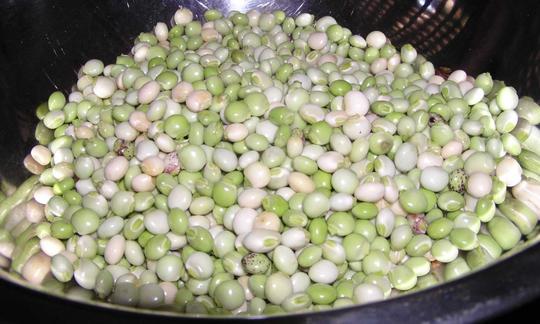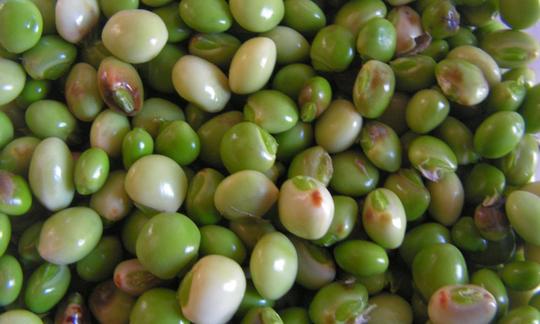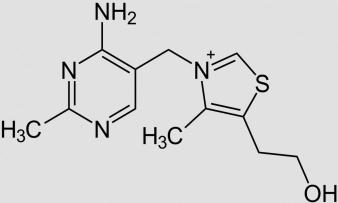Table of contents
Unripe seeds of the pigeon pea ( Cajanus cajan), also known as pigeon pea, have a mild, nutty taste and are particularly popular in Caribbean cuisine. Do not eat them raw and, whenever possible, look for organic quality when buying.
Use in the kitchen
Unripe pigeon peas are green in color and have a mild, nutty flavor that is less intense than the ripe seeds. Although they are actually beans, they are called peas because of their size. Both ripe and unripe seeds can be used in many ways in the kitchen. The green ones are used more for dishes that should have a fresh taste. Similar to edamame, they have a crunchy consistency. They cook relatively quickly and retain a delicate texture when prepared.
How can you prepare pigeon peas? Whether fresh or dried, you should definitely cook them before using them and, like other pulses, never eat them raw (see your own preparation). You can stew, sauté, steam and fry pigeon peas and use them in soups, stews, curries, sauces, salads and rice dishes. Their taste harmonizes perfectly with mango, coconut, onion, tomato, ginger, lemon juice, turmeric, coriander, cumin, curry powder, coconut milk and rice. The fresh beans are particularly valued in Caribbean cuisine.
Dishes with bean sprouts made from pigeon peas ("Taoge") are well-known and popular in India.
Homemade
If you buy fresh green pigeon peas, store them in the pod until ready to use. To shell them, boil them for five to seven minutes. Then place them in an ice bath to cool and shell them from the pod. Cooking inactivates the heat-sensitive trypsin inhibitors that can cause digestive upset in humans. 1 You can also store the beans in the pods until they dry out inside and turn brown. Then use them as dried beans (see mature pigeon pea seeds).
Vegan recipe for rice stew with pigeon peas
Ingredients (for 4 people): 1 tbsp rapeseed oil (refined), ½ onion, 2 spring onions, 1 sweet pepper (red), 1 tsp fresh thyme, 1 clove of garlic, 1 tsp smoked paprika powder, 250 g basmati rice, 250 gcorn, 250 g fresh pigeon peas (organic), 250 ml coconut milk (alternatively: oat cream), 500 ml vegetable stock, salt andpepper.
Preparation: Peel the onion and cut one half into thin half rings. Wash and chop the spring onions. Wash the sweet peppers and cut into strips. Peel and finely chop the garlic. Wash and chop the thyme. Heat a pan with rapeseed oil and add the vegetables to the pan together with the thyme. Sauté for about two minutes. Stir in the rice, pigeon peas and corn. Sauté for another minute. Add the coconut milk, vegetable stock and smoked paprika powder, bring to the boil, reduce the heat, put a lid on and simmer until the rice is cooked. Stir occasionally to avoid burning; add more water if necessary. Season with salt and pepper. Serve the vegan rice stew with fresh pigeon peas and enjoy immediately.
Vegan recipes with unripe pigeon peas can be found under the note: " Recipes that make the most of this ingredient ".
| Not only vegans or vegetarians should read this: Vegans often eat unhealthily. Avoidable nutritional errors. |
Purchasing - Storage
Major retailers such as Coop, Migros, Denner, Volg, Spar, Aldi, Lidl, Rewe, Edeka, Hofer, Billa or organic supermarkets such as Denn's Biomarkt and Alnatura do not usually stock pigeon peas. Good places to go instead are online retailers or Indian delicatessens, where you can often buy the beans frozen or in cans all year round. Buying organic quality can sometimes be difficult. In the growing areas (e.g. India), the first harvest season of ripe pigeon peas takes place in December and the second harvest in March. 20
The availability of unripe pigeon peas varies depending on the size of the store, catchment area, etc. Our recorded food prices for the DA-CH countries can be found above under the ingredient image - and by clicking on them you can see their development at various suppliers.
Storage tips
Fresh pigeon peas are best stored in a dry, cool place and consumed within three to four days. You can also freeze the freshly shelled seeds like green peas or edamame (unripe soybeans). Blanch pigeon peas for a few minutes beforehand. 2
Ingredients - Nutritional values - Calories
100 g of unripe pigeon peas provide 136 kcal of energy, which is made up of 1.6 g of fat, 24 g of carbohydrates and 7.2 g of protein. 3 The ingredients may change or be reduced during the cooking process.
Folate (ex Vit. B9, B11) is present in 100 g of unripe pigeon peas with 173 µg. This covers 87% of the daily requirement. Unripe cowpeas have similar values (168 µg/100g). Edamame contains higher amounts (303 µg/100g). 3
The vitamin C content is 39 mg/100g, which covers 49% of the daily requirement. Green peas contain a similar amount of the vitamin (40 mg/100g). Particularly good sources of vitamin C are sea buckthorn berries (450 mg/100g) or sweet peppers ( yellow : 184 mg/100g or red : 128 mg/100g). 3
100 g of unripe pigeon peas contain 0.4 mg of thiamine (vitamin B1). This covers 36% of the daily requirement. Durian has similar values (0.37 mg/100g). The outer layer of grains contains a particularly high amount of the vitamin, but also yeast flakes (41 mg/100g), although we only eat a small amount of it. 3
The pigeon pea also contains valuable secondary plant substances such as alkaloids, flavonoids, sterols and phenols. 4
The complete ingredients of unripe pigeon peas, the coverage of the daily requirement and comparison values with other ingredients can be found in our nutrient tables. In the article Nutrients explained you will get a detailed insight into the topic.
Health effects
Pigeon peas contain valuable carbohydrates, proteins, fats and minerals. Consumption brings several health benefits due to the presence of bioactive compounds. The beans can help control weight, help alleviate hypercholesterolemia and diabetes and are therefore also a remedy for metabolic syndrome (the occurrence of various symptoms such as obesity, high blood pressure and disorders of sugar and fat metabolism). 5 Carbohydrates, proteins, minerals, essential amino acids and vitamins are present in both the ripe (dried) and unripe seeds. 6
A study of the seeds, leaves and roots of C. cajan showed that the seeds have the best nutritional properties. In addition, they contain a relatively high content of essential amino acids and BCAAs ( branched - chain amino acids leucine, valine and isoleucine), which are even higher than in soybeans. BCAAs serve as building materials and fuel for muscle cells. The antioxidant activity , on the other hand, is higher in the roots of C. cajan than in the seeds and leaves. 7
Secondary plant substances
Many of the health effects of unripe pigeon peas can be attributed to the secondary plant substances they contain. Our article on secondary plant substances provides an overview of the classification of substance groups, their occurrence in foods and possible effects on humans.
In addition to the roots 7, the seeds also contain phytochemicals that exhibit antioxidant properties and may help alleviate and prevent health problems associated with oxidative stress, such as cancer and cardiovascular disease. 8 The seeds, leaves and roots of C. cajan contain significant amounts of saponins, which may help lower high blood cholesterol levels. Studies on cooked seeds have shown a significant reduction in blood sugar levels. 6
C. cajan is best known for its use in folk medicine to treat various ailments such as toothache, dizziness, diabetes, stomach pain, gynecological disorders and chronic infections. These properties are attributed to the presence of several valuable nutrients and bioactive components. 9
Dangers - Intolerances - Side effects
Raw pigeon pea seeds contain protein inhibitors (typsin and chymotrypsin) and amylase inhibitors, which impair the activity of digestive enzymes and can therefore cause digestive loss of nutrients. These can, however, be inactivated by cooking (exposure to heat). Raw pigeon peas also contain some of the oligosaccharides that cause flatulence, such as stachyose, raffinose and verbascose. These substances can also be inactivated before consumption by soaking, sprouting or cooking the seeds. 1 Soaking also reduces the phytic acid it contains, which insolublely binds minerals absorbed in the human stomach and intestines, such as calcium, magnesium, iron and zinc. 10 A longer soaking time also means a greater reduction in phytic acid. Read more about this in our article Phytic acid or phytate and soaking or sprouting.
Some people have allergic reactions or intolerances to the consumption of pulses, which include pigeon peas. 11 The spectrum of allergies is individual and can change over time. Pulses can cross-react with grass pollen, which means that an existing allergy to pollen from grass or grains can cause sensitization to pulses. 12 A distinction must be made between real allergies and intolerance reactions. Real allergies often occur immediately after eating the food and are manifested by severe itching in the mouth or a burning sensation in the throat. Food intolerances, on the other hand, manifest themselves during digestion, e.g. through flatulence or cramps.
Folk medicine - natural medicine
The leaves, seeds, stems and roots of C. cajan are used in traditional medicine to treat various ailments such as toothache, diabetes, dizziness, baldness and gastrointestinal complaints in some areas of India, Bangladesh and China. In Oman, the seeds of C. cajan are used to relieve chronic infections and the locals use the juice of the leaves to treat various dermatological diseases. In ancient times, the flower decoction was used to treat pneumonia, coughs, menstrual cramps, dysentery and bronchitis. While the leaf decoction was used in eastern Nigeria to treat measles. 9
Ecological footprint - animal welfare
The ecological footprint of a food depends on various factors. The type of agricultural production (conventional vs. organic), seasonal, regional or domestic production or import by truck, ship or plane, different types of packaging and whether the goods are fresh or frozen all play a decisive role. 13
Green pigeon peas are calculated to have a CO 2 footprint of 0.92 kg CO 2 eq/ kg.14 In comparison, green peas are given a CO 2 footprint of between 0.4 (in pods) and 1.19 kg CO 2 eq /kg (shelled) .13,15 If the peas are canned or frozen, the value increases accordingly.13,15 If pigeon peas are exported, an additional burden from transport emissions can be expected.
The amount of water required to produce 1 kg of pigeon peas is 5494 litres. It is not clear from the study whether this water footprint refers to dried or fresh specimens. 16
For detailed explanations of various sustainability indicators (such as ecological footprint, CO2 footprint, water footprint), see our article: What does the ecological footprint mean?
In addition to being used as a main crop, pigeon peas are also used for intercropping or as green manure. As legumes, they can fix atmospheric nitrogen and make it available for the subsequent crop. They are popular with main crops such as millet, sorghum, corn or cowpeas. 19
Worldwide distribution - cultivation
Cajanus cajan is thought to have originated in India, where it has been cultivated for at least 3,700 years. The earliest archaeological evidence points to the southern peninsula and the east of the country, with it expanding into Thailand around 2,000 years ago. 17 Today it is native to much of Asia, Africa, Central America and northern South America, 18 preferring tropical and subtropical climates and is considered a fast-growing and adaptable legume. 6
Cultivation - Harvest
Cajanus cajan can also be grown in your own garden under certain conditions. The short-lived, perennial plant usually lives for 3 to 5 years and produces its most productive harvest in its first year. It takes about 120 to 200 days to reach full maturity. They can reach a height of up to 3.5 m. 2 The pigeon pea is a tough plant and grows in a variety of soil types, from sandy to heavy clay soils and also in soils with low fertility. It grows best in soils with a pH value of 5-7, but it is also tolerant of a wider range (4.5-8.4). Like all pulses, it does not tolerate waterlogging and flooding over a long period of time well. On the other hand, it is very heat tolerant and thrives well in hot, humid climates, with annual rainfall between 600 and 1000 mm. Temperatures between 18 °C and 30 °C are optimal for its growth. However, it can also thrive in moist soil conditions at temperatures of 35 °C or more. 19
Sow the seeds as spring temperatures warm up. Before sowing, till the soil a few inches deep and press the seeds into the soil about an inch, spacing seeds about 4 inches apart. Water the plant well and keep the soil moist until it sprouts, which may take a couple of weeks. The first few weeks after seed germination are important. Make sure the soil is moist but not wet and the area is free of weeds. The plant does well without additional fertilizer and usually takes up to a month to establish itself. Once they are about 5 inches tall, growth picks up speed and can reach up to 5 inches per week. At this point, you can scale back on care a little. 2
Harvesting pigeon peas is easy. Keep an eye on the plants; once they form flowers, you should be able to harvest fresh green peas a few weeks later. You can pick them by hand, but be careful not to tear off entire branches. You can also use scissors to cut off the fresh pods. Store them in an airtight bag in the refrigerator for two to three days before shelling, or, if you shell them before storing, in an airtight container for up to a week. The plants flower heavily over the course of about six weeks, so you can harvest either fresh, young or dried pigeon peas for about six weeks—or a mix where you harvest some while they're still green and save others for dried peas. 2
Further information
Pigeon peas ( Cajanus cajan) belong to the legume family (Fabaceae). The color of the pigeon peas (green or brown) indicates the degree of ripeness of the legume. If the pea is still green, it has been harvested at an earlier stage. Brown pigeon peas, on the other hand, ripen and dry on the plant before being harvested.
Alternative names
In German, the pigeon pea is also known as Erbsenbohne or Tauberbose. In English, it is called pigeon peas (pigeonpea) or red gram, Angola pea or Congo pea. In Spanish, it is known as Gandules (verdes), Guandules, Guandúl, frejol de palo or Quinchoncho and in India, Arhar and Toor Dal are common names.
Latin synonyms are: Cajanus indicus Spreng., Cajanus fllavus DC. and Cytisus cajan L. 17
Other uses
In addition to its use as food, the leaves are used as animal feed and the woody parts as firewood. The stems are also used as roof straw and for temporary fences. 19
In India and Thailand, shellac was used, which is produced by the scale insects Laccifer lacca that live on Cajanus plants. In Madagascar, pigeon pea leaves are used as food for silkworms. 21
Bibliography - 20 Sources
| 1. | Sharma S, Agarwal N, Verma P. Pigeon pea (Cajanus cajan L.): A Hidden Treasure of Regime Nutrition. Journal of Functional and Environmental Botany. 2011;1(2):91–101. |
| 2. | Gardeners Path com: How to Plant and Grow Pigeon Peas. 2022. |
| 3. | USDA United States Department of Agriculture. |
| 4. | Gerrano AS, Moalafi A, Seepe HA, Amoo S, Shimelis H. Nutritional and phytochemical compositions and their interrelationship in succulent pods of pigeonpea (Cajanus cajan [L.] Millsp.). Heliyon. 2022;8(3):e09078. |
| 5. | Talari A, Shakappa D. Role of pigeon pea (Cajanus cajan L.) in human nutrition and health: A review. Asian Journal of Diary and Food Research. 2018;37(3):212–220. |
| 6. | Kuraz Abebe B. The Dietary Use of Pigeon Pea for Human and Animal Diets. The Scientific World Journal. 2022;2022:1–12. |
| 7. | Yang SE, Vo TLT et al. Nutritional Composition, Bioactive Compounds and Functional Evaluation of Various Parts of Cajanus Cajan (L.) Millsp. Agriculture. 2020;10(11):558. |
| 8. | Tekale SS, Jaiwal BV, Padul MV. Identification of metabolites from an active fraction of Cajanus cajan seeds by high resolution mass spectrometry. Food Chemistry. 2016;211:763–769. |
| 9. | Gargi B, Semwal P et al. Revisiting the Nutritional, Chemical and Biological Potential of Cajanus cajan (L.) Millsp. Molecules. 2022;27(20):6877. |
| 10. | Chemie de: Phytinsäure. |
| 11. | Aha! Allergiezentrum Schweiz. Erbsen sind im Trend – aber auch allergen. 2021. |
| 12. | DEBInet Deutsches Ernährungsberatungs- & Informationsnetz. Nahrungsmittelallergien - Pollen. |
| 13. | Reinhardt G, Gärtner S, Wagner T. Ökologische Fussabdrücke von Lebensmitteln und Gerichten in Deutschland. IFEU Institut für Energie- und Umweltforschung Heidelberg ifeu. 2020:1-22. |
| 15. | Concito. Denmark's green think tank. The big Climate Database. Version 1.1. Peas, green. 2024. |
| 16. | Mekonnen MM, Hoekstra AY. The green, blue and grey water footprint of crops and derived crop products. Hydrol. Earth Syst. Sci. 2011;15:1577–1600. |
| 17. | Fuller DQ, Murphy C et al. Cajanus cajan (L.) Millsp. origins and domestication: the South and Southeast Asian archaeobotanical evidence. Genet Resour Crop Evol. 2019;66(6):1175–1188. |
| 18. | Royal Botanic Gardens Kew. Cajanus cajan (L.) Huth. |
| 19. | Universität of Hawai Manoa. Valenzuela H, Smith J. Pigeonpea. Sustainable Agriculture Green Manure Crops. 2002:1–3. |
| 20. | Venkataratnam N, Sheldrake AR. Second harvest yields of medium duration pigeonpeas (Cajanus cajan) in peninsular India. Field Crops Research. Januar 1985;10:323–32. |
| 21. | Uni-Giessen. Leguminosen zur Kornnutzung. Straucherbse (Cajanus cajan [L.] Millsp. [= C. indicus Spreng.]) 2015. |










Comments